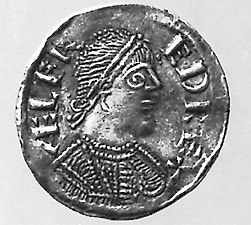British Museum Unveils Viking Hoard Discovered in a Farmer’s Field
December 17, 2015
Seven pieces of Viking jewelry, 15 silver ingots, and 186 early medieval coins minted in England during the late 800’s—not a bad afternoon’s find for an amateur treasure hunter armed with a metal detector. James Mather, the hobbyist who made the discovery, has called it “every detectorist’s dream.”

Alfred the Great was king of the West Saxons in England from A.D. 871 to 899. This coin bears an image of Alfred and the words Aelfred Rex, which mean King Alfred in Latin. The coin is a silver penny made about A.D. 886. Courtesy of British Museum, London
Last week, the British Museum in London unveiled the Watlington hoard, as Mather’s discoveries are now known. Mather found the artifacts in October about 40 miles (64 kilometers) west of London on farmland near the town of Watlington. He initially thought his equipment might have detected a silver ingot, but when he dug a small hole, he found a cache of coins. He quickly notified local authorities. The “icing on the cake,” he claimed, was getting to spend his 60th birthday assisting with the excavation of the hoard. Clay soil with the artifacts embedded in it was scooped out and encased in cling wrap for delivery to the British Museum. If the hoard is officially declared a treasure under British law, Mather and the landowner will be entitled to split a reward equal to the market value of the items.
For the museum researchers, the reward will be the clues these objects supply about a pivotal time in English history—the reign of King Alfred the Great, who ruled the kingdom of Wessex in southwestern England from 871 to 899. Some coins in the hoard portray two emperors seated together. They were issued jointly during a brief alliance between Alfred and Ceolwulf II, the king in neighboring Mercia from 874 to 879. Both men ruled Anglo-Saxon kingdoms. The Anglo-Saxons were descendants of Germanic tribes that had invaded southern and eastern Britain in the 400’s and 500’s and eventually established small kingdoms there.
The arm-band jewelry in the Watlington hoard is of Viking origin. In the 800’s, Scandinavian Vikings began raiding England. Deciding it was a nice place to visit and they did want to live there, some raiders became invaders who seized land for settlement. By the late 800’s, Danish Vikings had overwhelmed all the Anglo-Saxon kingdoms except Wessex. In 878, Alfred managed to defeat a force led by the Viking leader Guthrum at the Battle of Edington. As a result, Guthrum agreed to be baptized a Christian and to stay north and east of the River Thames. His Viking force slowly retreated north through Mercia into East Anglia. Historians do not know who hid the Watlington hoard, or why, but they believe it was buried in the years just following this decisive battle.
Although the Vikings later broke the peace, Alfred again resisted successfully. He took London in 886. He built forts and a fleet. Eventually, all the English people not subject to Viking rule recognized him as their ruler. The formerly separate Anglo-Saxon kingdoms began to merge into one.
In the 21st century, Alfred also has emerged as a television star. “The Last Kingdom,” which coincidentally premiered on BBC in October of this year, follows the story of Uhtred, a fictional Saxon child raised by Danes in the mid-800’s. Despite his conflicted loyalties, Uhtred becomes a follower of Alfred. The final episode of the season portrayed the climactic Battle at Edington.
Additional World Book articles:
- Anglo-Saxon Chronicle
- Archaeology (2004) (a Back in Time article)


